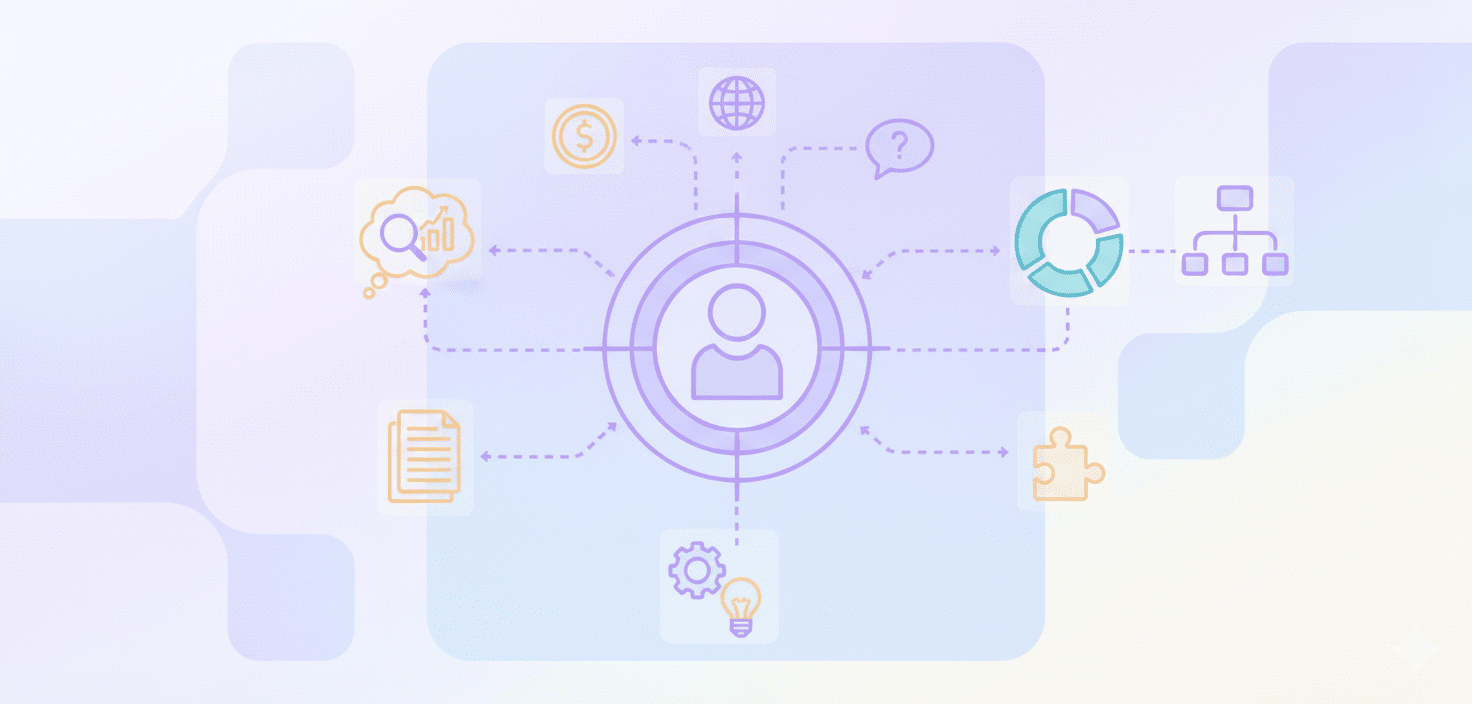análisis de mercado
¿Qué es un perfil de cliente ideal (ICP) de SaaS?

¿Qué es un perfil de cliente ideal (ICP) de SaaS?
Un perfil de cliente ideal (ICP) de SaaS es una descripción completa de una empresa que se beneficiaría al máximo de su producto o servicio SaaS.
Para identificar los rasgos que realmente distinguen a su público objetivo, hay que ir más allá de los simples datos demográficos.
Las empresas de SaaS con un ICP definido pueden experimentar hasta un cambio del 68 % en las tasas de éxito (LinkedIn, n.d.), lo que puede influir en el enfoque publicitario y la eficiencia de las ventas (M1-Project, n.d.).
Para garantizar que satisfaga las demandas reales del mercado, recuerde que un ICP bien definido es dinámico y debe actualizarse con frecuencia para reflejar los cambios del mercado y el desarrollo de su producto.
¿Cuáles son las características clave de un cliente de SaaS ideal?
El consumidor de SaaS ideal presenta una combinación de características firmográficas, conductuales, tecnográficas y demográficas que están muy alineadas con la propuesta de valor de su producto.
- Rasgos demográficos y firmográficos
- Algunos ejemplos son los ingresos, el sector y el tamaño de la empresa.
- Proporcionan una idea básica
- Características conductuales
- Los puntos de dolor, los desencadenantes de compra y los motivos son algunos ejemplos.
- Demuestran que el cliente requiere una solución SaaS.
- Características tecnológicas
- Algunos ejemplos son las tecnologías preferidas, las integraciones y las herramientas actuales.
Ejemplo:
Un SaaS de automatización de marketing podría dirigirse a empresas medianas de comercio electrónico (firmográfico) con dificultades en la generación de leads (conductual), que utilizan HubSpot (tecnográfico) y que buscan aumentar las tasas de conversión de ventas (resultado deseado).
Comprender estas características permite realizar acciones de marketing y ventas dirigidas, mejorando la adquisición y retención de clientes al centrarse en los clientes con más probabilidades de beneficiarse de su producto SaaS.
¿Cómo se crea un perfil de cliente ideal para su SaaS?
La creación de un perfil de cliente ideal (ICP) para tu SaaS comienza con la recopilación de datos y termina con un perfeccionamiento continuo.
- Recopilar datos
- Analizar:
- Datos demográficos, psicográficos, de comportamiento y transaccionales
- Fuentes: encuestas, entrevistas, análisis web, plataformas CRM, historiales de compra
- Desarrollar una plantilla de ICP
Incluir:
- Industria
- Tamaño de la empresa
- Ingresos anuales
- Ubicación geográfica
- Stack tecnológico
- Puntos débiles
- Preferencias de compra
- Perfeccionar continuamente
- Utiliza datos reales e información relevante para actualizar tu ICP a medida que el mercado y el producto evolucionan.
Ejemplo:
Una empresa SaaS podría dirigirse inicialmente a todas las pequeñas empresas, pero después refinar su ICP para centrarse en agencias de marketing de entre 10 y 50 empleados que utilizan herramientas específicas de automatización de marketing y tienen dificultades con la generación de leads.
- Colabore con los equipos de ventas
Incluya a los equipos de ventas en el proceso de creación del ICP para aprovechar sus conocimientos directos sobre los comportamientos y preferencias de los clientes para una mayor precisión.
¿En qué se diferencia un ICP de un buyer persona?
Una ICP identifica el encaje ideal de la empresa, centrándose en características generales, mientras que una buyer persona representa a un cliente individual dentro de esas empresas, detallando sus motivaciones y puntos de dolor.
|
Aspecto |
Perfil de Cliente Ideal (PCI) |
buyer persona |
|
Enfoque |
Adecuación a nivel de empresa |
Decisor individual |
|
Finalidad |
Orientación y segmentación |
Marketing personalizado |
|
Tipo de dato |
Firmográfico, tecnográfico |
Conductual, psicográfico |
|
Resultado |
Orientación estratégica |
Interacción táctica |
Los ICP son marcos estratégicos para identificar a las empresas adecuadas, mientras que los buyer personas ayudan a diseñar campañas personalizadas.
¿Qué eventos desencadenantes impulsan a los clientes potenciales ideales a buscar su SaaS?
Los eventos desencadenantes son sucesos específicos que señalan la disposición de un cliente potencial para explorar soluciones SaaS.
Ejemplos de eventos desencadenantes
- Cambios organizativos o reestructuración
- Cambios en la industria o nuevas normativas
- Nuevas rondas de financiación u ofertas de empleo
- Interacción con contenido relevante (webinars, whitepapers, etc.)
- La identificación de estos eventos desencadenantes y la reacción a ellos puede influir en la duración del ciclo de ventas y tasas de conversión.
Sin embargo, los eventos desencadenantes siempre deben utilizarse junto con los criterios de cualificación para confirmar la preparación del cliente potencial.
¿Cuáles son los pasos clave en el proceso de compra de mi cliente ideal y los posibles obstáculos?
Estos son los pasos y los desafíos:
Pasos clave en el proceso de compra
- Reconocimiento del problema/necesidad — El cliente identifica un desafío que su SaaS puede resolver.
- Investigación y evaluación — El cliente explora las soluciones disponibles y evalúa a los proveedores.
- Compra e implementación — Varios interesados toman una decisión e implementan la solución.
- Evaluación poscompra — El cliente evalúa el rendimiento, el ROI y el éxito de la integración.
Ejemplo:
Un equipo de marketing con dificultades para generar leads podría investigar software de CRM, probar versiones de prueba gratuitas y comprar la solución que mejor se adapte a su flujo de trabajo y presupuesto.
Posibles obstáculos
- Toma de decisiones compleja (a menudo entre 5 y 8 partes interesadas)
- Altos iniciales Adquisición de Clientes obstáculos
- Desafíos de integración o compatibilidad del flujo de trabajo
Conclusión
Establecer su perfil de cliente ideal de SaaS es esencial para una expansión enfocada y una gestión eficaz de los recursos.
Puede mejorar sus esfuerzos de marketing y ventas identificando los eventos desencadenantes, mapeando el proceso de compra, creando un ICP exhaustivo y comprendiendo las características esenciales de su cliente ideal.
Concentrarse en los clientes adecuados puede estar relacionado con la generación de ingresos y el establecimiento de conexiones sostenidas y recíprocas, con implicaciones para la viabilidad a largo plazo en el mercado SaaS.